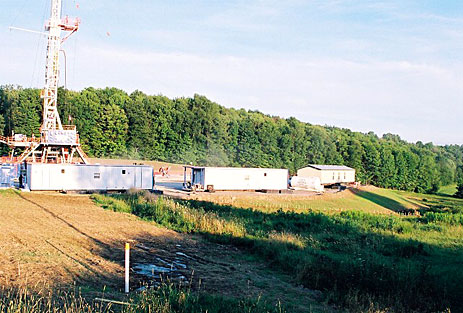The New York Times has a long article in this weekend's magazine about hydraulic fracturing in southwestern Pennsylvania. It tries to capture the culture of the place and to show the tensions for people who have an economic interest in drilling but are at risk of suffering health impacts. But it also manages to glance off some of the scarier tensions in the area among citizens, government, and corporate interests.
The story's set in Washington County, which is a rural area south of Pittsburgh. The people populating the story talk about "country folk and city people." They say things like "A man's word means a lot here," and "my grandfather taught me water is life." Stacey Haney, one of the main characters , is a "self-proclaimed redneck who is proud to trace her roots here back at least 150 years." Eliza Griswold, the reporter, makes multiple mentions of a county fair, where "as usual, Pappy's butternuts placed first."
All these details appears to exist in order to draw a distinction between the good people of Washington County and shrill fracking activists, although that's never said explicitly. Haney finds that her family is falling ill and connects it fracking. The point seems to be that even these good people who support natural gas drilling for economic and environmental reasons aren't having the best experience with it.
There are a few crucial points that Griswold grazes over, though. Range Resources, the natural gas company in this story, lurks in the background, forbidding her access to a fracking site and denying records of complaints residents have made. Other reports have shown this particular company to be much more manipulative in its relations with Pennsylvania communities: This American Life did a great job of documenting how the company messed with a town council trying to pass drilling regulations. Griswold doesn't dig into that part of the story, preferring to focus on Pappy’s butternuts. She also mentions the state's Department of Environmental Protection but doesn't delve into its sad record as a friend of industry.
The story does do a good job of showing how the supposed economic benefits of fracking aren't the windfall promised:
Stacey used most of her $9,000 check to pay off the bills she incurred: $4,500 went to co-pays and deductibles for doctors’ visits; $1,150 went to pay for gas. She set $2,700 aside to pay taxes on the earnings. The remaining $750 she used as a down payment on a camper.
But that point's drowned out by Griswold's interest in documenting how country the frackees are. It's possible that this story will win over some fence-sitters to dangers of fracking. But anyone who already understands the issue should probably skip it, to avoid getting ticked off.



